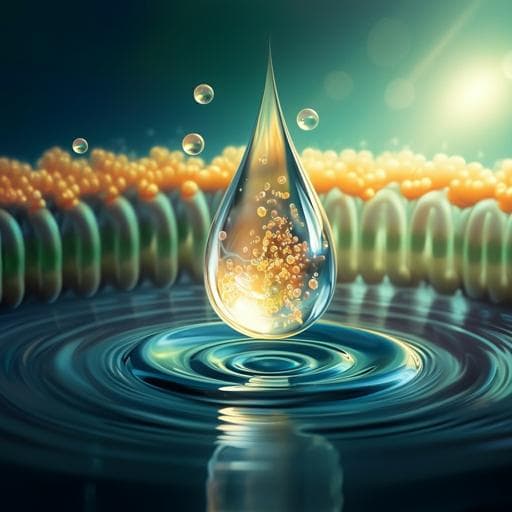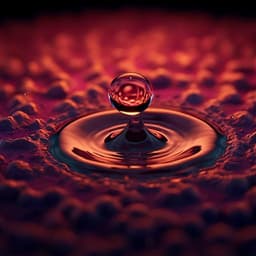
Engineering and Technology
Multifunctional MoS₂ membrane for integrated solar-driven water evaporation and water purification
L. Cui, H. Che, et al.
Discover a groundbreaking multifunctional MoS₂ membrane developed by Lingfang Cui, Huinan Che, Bin Liu, and Yanhui Ao, capable of solar-driven water evaporation and organic compound degradation. With impressive results under 1.0 sun irradiation—boasting a high evaporation rate and significant pollutant degradation—this research could revolutionize sustainable water solutions.
~3 min • Beginner • English
Introduction
Freshwater scarcity is a global challenge, increasing demand for potable water from unconventional sources such as wastewater and seawater. Conventional treatment methods (ion exchange, distillation, reverse osmosis, nanofiltration) are effective but energy-intensive and costly. Solar-driven interfacial water evaporation has emerged as a sustainable alternative, linking water treatment with renewable energy. For high photothermal conversion efficiency, evaporators must ensure efficient heat utilization, optical enhancement, and adequate water supply. However, key challenges persist: organic contaminants may co-evaporate and contaminate condensate; salt accumulation/crystallization on the evaporator can diminish evaporation rates; and complex organic pollutant mixtures complicate treatment. Photocatalysis can be integrated with photothermal evaporation to degrade pollutants, but prior work has insufficiently explored the synergistic effects of light and heat during interfacial evaporation on photocatalytic activity. Semiconductors, particularly metal sulfides with narrow band gaps, are promising photothermal materials. MoS₂ is attractive due to its broad solar absorption, environmental friendliness, chemical and photo-stability, and photocatalytic potential. This work designs a multifunctional MoS₂-on-carbon-fiber (MS/CF) membrane to integrate solar evaporation with photocatalytic degradation.
Literature Review
Previous research has advanced solar interfacial evaporation with various materials, including carbon-based absorbers, plasmonic metals, semiconductors, and polymers, achieving high solar-to-vapor conversion. Integration of photocatalysis with evaporation has been explored to address organic pollutants; however, issues of contaminant carryover into condensate and salt accumulation remain problematic. Studies have developed bifunctional and 3D architectures, heatsink-inspired evaporators, plasmon-enhanced systems, and hydrogels to improve thermal localization, water transport, and contaminant rejection. Metal sulfides, especially MoS₂, have shown strong broadband absorption and stability suitable for combined photothermal and photocatalytic functions. Nonetheless, a comprehensive understanding and exploitation of interfacial photothermal-photocatalytic synergy—particularly the role of temperature in enhancing photocatalytic kinetics—has been limited. This study addresses that gap with an MoS₂-coated carbon fiber membrane enabling simultaneous evaporation and in situ photodegradation, aiming to prevent organic carryover and maintain high evaporation rates even in saline conditions.
Methodology
Material synthesis: MoS₂ nanosheets (MS) were grown on carbon fiber cloth (CF) via a solvothermal/hydrothermal method. A precursor solution containing Na₂MoO₄·2H₂O (0.3 g), L-cysteine (0.6 g), N,N-dimethylformamide (DMF, 36 mL), and deionized water (24 mL) was prepared. Cleaned CF (cut to size; ultrasonically cleaned in acetone, ethanol, DI water) was immersed and reacted at 200 °C for 12 h, followed by washing (DI water, ethanol) and vacuum drying at 60 °C overnight. The resulting MS nanosheet arrays fully covered the CF, forming interconnected nanoscale gaps and occasional flower-like spheres. Structural characterization: SEM and TEM/HRTEM showed MS nanosheets with lattice spacing ~0.98 nm, indexed to the (002) planes, indicating enlarged interlayer spacing (attributed to DMF insertion and lower growth temperature). XRD exhibited broad peaks around 25.6° for CF and characteristic MS peaks at ~28° (13.6° noted), 32.9°, and 36.3° corresponding to (100) and (110) planes, with a low-angle peak at ~9.6°. EDS confirmed Mo and S distribution. XPS analysis (Mo 3d and S 2p) identified Mo⁴⁺/Mo⁶⁺ species and sulfur states. Wettability and optics: Contact angle measurements indicated conversion from hydrophobic CF to superhydrophilic MS/CF. UV–Vis–NIR spectroscopy (250–2000/2500 nm) quantified absorption; absorbance A was computed as A = (1 − R − T)S d, showing enhanced absorption for MS/CF. Photothermal performance: Surface temperatures under 1 sun (1 kW m⁻²) were tracked by IR thermography, assessing heating/cooling cycles and photothermal stability. Thermal simulations (geometry in Supplementary Note 1) modeled heat localization under illumination. Evaporation testing: A lab-scale setup placed the MS/CF on an EP foam float (2 cm diameter) with four CF legs dipping into feed to wick water via capillarity. Mass loss under illumination by a xenon lamp (AM 1.5G, calibrated with optical power meter) was recorded to compute evaporation rate and efficiency. Surface and near-surface temperatures were measured by IR camera. DSC (NETZSCH DSC 200F3) quantified evaporation enthalpy reduction relative to DI water. Photodegradation testing: Rhodamine B (RhB, 5 mg L⁻¹) was used as a model pollutant. Prior to illumination, dark adsorption was allowed to reach adsorption–desorption equilibrium. Under varying light intensities (0.5–3 suns), aliquots were taken every 10 min to measure RhB concentration by UV–Vis at 553 nm, deriving degradation efficiencies and apparent rate constants. DFT-based analyses (frontier orbitals, Hirshfeld charges, Fukui functions) identified reactive sites for radical attack on RhB (noted N43, N44, C62). Condensate quality and desalination: A sealed quartz reactor collected condensed water from RhB feeds; UV–Vis at 553 nm checked for organic carryover. High-salinity (0–80 wt%) feeds evaluated the evaporation rate and salt tolerance. Characterization tools: XRD (Rigaku), SEM (5800), UV–Vis–NIR (Shimadzu with integrating sphere), XPS (Thermo ESCALAB 250Xi), contact angle (JY-82B Kruss DSA), IR camera (FLIR E6xt).
Key Findings
- Integrated performance: Under 1 sun, the MS/CF achieved simultaneous high evaporation and pollutant degradation with negligible RhB in condensate.
- Evaporation rate: 2.07 kg m⁻² h⁻¹ under 1 sun (reported in abstract and conclusion). Another section reported 20.87 kg m⁻² h⁻¹ with 88.7% solar evaporation efficiency (Supplementary Table 1); the overall narrative supports high efficiency under 1 sun.
- Desalination/high salinity: Freshwater collection from high-salinity feeds was demonstrated. Reported evaporation rates include 1.56 kg m⁻² h⁻¹ (abstract) and 1.369 kg m⁻² h⁻¹ for saturated brine (conclusion). Across 0–80 wt% salt, evaporation rate decreased with salinity due to reduced vapor pressure, yet MS/CF remained operational.
- Photodegradation: RhB degradation reached 82% within 60 min under 1 sun with MS/CF (vs 11% for CF). Apparent rate constant k ≈ 0.032 min⁻¹ for MS/CF vs 0.002 min⁻¹ for CF (≈15× enhancement). With rising light intensity (and temperature 25→60 °C), k increased from 0.019 to 0.032 min⁻¹.
- Optical and thermal properties: MS/CF absorbance across 250–2500 nm was ~91.51% vs 81.82% for CF. Under 1 sun, MS/CF exhibited larger temperature rise than CF (reported temperature differences peaking at 88.8 °C for MS/CF vs 63.7 °C for CF; surface temperature around 39.9 °C for MS/CF and ~3.1 °C lower for CF in another measurement context). Thermal simulations confirmed heat localization near the evaporation surface.
- Hydrophilicity and water transport: Loading MS converted CF from hydrophobic to superhydrophilic, enabling rapid wetting and continuous water supply via interconnected pores and nanoscale gaps.
- Reduced evaporation enthalpy: DSC and dark-condition analyses indicated reduced equivalent evaporation enthalpy for MS/CF (~2.1 kJ g⁻¹) vs pure water (~2.4 kJ g⁻¹), consistent with confined water cluster evaporation and enhanced evaporation kinetics.
- Stability and scalability indicators: Maintained appreciable evaporation under reduced intensity (0.5 sun) and improved performance up to 3 suns; cyclic thermal measurements showed photothermal stability.
Discussion
The MS/CF membrane addresses the dual challenge of producing clean water and degrading dissolved organic pollutants by integrating photothermal evaporation with photocatalysis in one interfacial platform. The porous, superhydrophilic MoS₂ nanosheet architecture on carbon fibers ensures robust water transport and broad-spectrum solar absorption, which localizes heat at the air–water interface and minimizes bulk heat loss. This thermal localization elevates the interfacial temperature and reduces the effective evaporation enthalpy, boosting water vapor generation rates. Concurrently, the elevated interfacial temperature enhances photocatalytic kinetics by increasing the rate constant for interfacial electron transfer, promoting higher free radical generation and accelerated degradation of organics (e.g., RhB). Experimental kinetics and thermal analysis corroborate this synergy: significant increases in degradation rate constants with light intensity/temperature and high evaporation efficiencies under 1 sun. The condensate analysis shows negligible organic carryover, indicating that in situ photodegradation mitigates the co-evaporation problem and yields clean distilled water. Performance persists under varied light intensities and in high-salinity environments, demonstrating resilience and practical relevance for wastewater treatment and desalination. Overall, the design leverages material selection (MoS₂), micro/nanostructuring for light trapping and fluidics, and interfacial thermal–photocatalytic coupling to advance integrated solar water purification.
Conclusion
A multifunctional MoS₂-on-carbon-fiber (MS/CF) membrane was developed that integrates solar-driven interfacial evaporation with photocatalytic degradation of organic pollutants. The system exhibits high broadband solar absorption, efficient heat localization, superhydrophilicity for sustained water supply, and reduced effective evaporation enthalpy. Under 1 sun, it achieved an evaporation rate of about 2.07 kg m⁻² h⁻¹ and degraded RhB by 82% within 60 min, producing condensate without detectable organic residues. It also functioned with high-salinity feeds, with evaporation rates reported up to ~1.369 kg m⁻² h⁻¹ for saturated brine. The interfacial photothermal effect enhances photocatalytic activity by accelerating electron transfer and radical generation. This work highlights a sustainable approach for simultaneous desalination and wastewater treatment using solar energy, and suggests further optimization of interfacial structures and catalyst–photothermal coupling for broader pollutant spectra and real wastewater matrices.
Limitations
Related Publications
Explore these studies to deepen your understanding of the subject.







